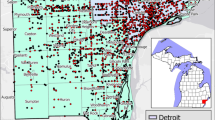Abstract
Research on the location of hazardous facilities that contribute to environmental degradation indicates an unequal distribution of such sites within low socioeconomic status communities. In this paper, we contribute to research investigating whether there are similar patterns of unequal prioritization in environmental remediation, by assessing cleanup of a broader, more diverse set of contaminated sites, all brownfields that receive federal grants, with a finer level of geographic detail than previous studies. First, we set the context by assessing the characteristics of the communities in which brownfield sites are currently located. Then, we compare the likelihood and temporal prioritization of cleaning up brownfield sites based on the composition of the neighborhoods in which they are located. We find that brownfield sites are more likely to be located in both poor and predominantly minority communities, but while sites located in poor communities tend to be cleaned up relatively quickly, sites located in communities with larger minority populations tend to be cleaned up more slowly.


Similar content being viewed by others
Notes
See http://www.epa.gov/brownfields/overview/glossary.htm. Web site viewed by author on November 2, 2010.
Public Law 107-118 (H.R. 2869): "Small Business Liability Relief and Brownfields Revitalization Act".
The IRCHS is a product of the Clean Manufacturing Technology Institute at Purdue University. For a detailed description of the IRCHS, please see: http://engineering.purdue.edu/CMTI/IRCHS/.
In cases where a tract had more than one site, for which cleanups began both before and after 2000, 1990 data were used. All models were also assessed with an average of 1990 and 2000 demographic characteristics, with no substantive differences in the results.
The US Government Accountability Office estimated in 2004 that there were between 450,000 and 1,000,000 brownfield sites nationwide, although this is probably a conservative estimate. See: http://www.gao.gov/new.items/d0594.pdf.
Since we collected the full set of data on October 1, 2009, we use this date as the censoring point. The date itself is not indicative of a milestone in the brownfield policy process.
Given that our data are national, we opted to use this measure of economic factors rather than a raw dollar amount like median income because eligibility for public assistance usually takes into account the variable cost of living in different areas.
Several aspects of the housing stock were included in various models, such as the median home value and median home size. These variables were dropped from the final analysis over concern that they may be highly correlated with other variables that were retained.
It may well be that the actual hazard is more multiplicative than additive when more than one pollutant is present, but without knowing specific quantities of contaminants at the site, additive effects seem to be the more conservative assumption.
We also assessed clustering via a count of sites located in the same census tract as the focal site. We opted to use the indicator variable due to our concern that a few census tracts that contained a very large number of sites would have an undue influence on our results.
There is some overlap in the first time period between George H.W. Bush’s term and Bill Clinton’s first term. We operationalized this variable in a number of different ways: as non-ordinal dummies, as year dummies, and as months counting backward from October, 2009 to January 1990. Results were not substantially different under any other consideration of the time variable, so we opted for the ordinal category operationalization corresponding to Presidential terms as the best way to capture periods of both similar technology and political control of the federal government.
Several alternate specifications of this model were assessed, including other aspects of the housing stock and socioeconomic status of the population. We add a caveat to these results by noting that we did not have data regarding the specific land-use requirements or zoning regulations that were applicable to each of the tracts in the analysis. Nevertheless, these results are useful for detailing where brownfield sites tend to be located so that the results of the subsequent analysis can be interpreted in context.
In fact, removal of these change variables does not change the interpretation of the key variables assessed. We retain them, however, as a control variable to help account for those neighborhoods that were undergoing demographic changes. We should also note that quadric and interaction terms were assessed for the socioeconomic status variables; inclusion of these variables did not change the substantive results.
References
Alberini, A., Longo, A., Tonin, S., Trombetta, F., & Turvani, M. (2005). The role of liability, regulation and economic incentives in brownfield remediation and redevelopment: Evidence from surveys of developers. Regional Science and Urban Economics, 35, 327–351.
Allison, P. (1984). Event history analysis: Regression for longitudinal event data. Thousand Oaks, CA: Sage.
Arora, S., & Cason, T. (1999). Do community characteristics influence environmental outcomes? Evidence from the toxics release inventory. Southern Economic Journal, 65(4), 691–716.
Atlas, M. (2002). There goes the neighborhood: Environmental equity and the location of new hazardous waste management facilities. Policy Studies Journal, 30(2), 171–192.
Banzhaf, H., & Walsh, R. (2008). Do people vote with their feet? An empirical test of Tiebout’s mechanism. American Economic Review, 98(3), 843–863.
Been, V., & Gupta, F. (1997). Coming to the nuisance or going to the barrios? A longitudinal analysis of environmental justice claims. Ecology Law Quarterly, 24(1), 1–56.
Bonorris, S. (2004). Environmental justice for all: A fifty-state survey of legislation, policies and initiatives. San Francisco, CA: American Bar Association and Hastings College of Law.
Bowen, W., Atlas, M., & Lee, S. (2008). Industrial agglomeration and the regional scientific explanation of perceived environmental justice. Annals of Regional Science, 43, 1013–1031.
Bullard, R. (2001). Environmental justice in the 21st century: Race still matters. Phylon, 49(3/4), 151–171.
Campbell, H., Peck, L., & Tschudi, M. (2010). Justice for all? A causal analysis of toxics release inventory facility location. Review of Policy Research, 27(1), 1–25.
Commission for Racial Justice for the United Church of Christ. (1987). Toxic wastes and race in the United States: A national report on the racial and socio-economic characteristics of communities with hazardous waste sites.
Daley, D., & Layton, D. (2004). Policy implementation and the environmental protection agency: What factors influence remediation at superfund sites? Policy Studies Journal, 32(3), 375–392.
De Sousa, C. (2004). The greening of brownfields in American Cities. Journal of Environmental Planning and Management, 47(4), 579–600.
Dull, M., & Wernstedt, C. (2010). Land recycling, community revitalization, and distributive politics: An analysis of EPA brownfields program support. Policy Studies Journal, 38(1), 119–141.
Eckerd, A. (2011). Cleaning up without clearing out? A spatial assessment of environmental gentrification. Urban Affairs Review, 47(1), 31–59.
Fitzgerald, J., & Leigh, N. (2002). The brownfield redevelopment challenge. From economic revitalization (pp. 69–101). Thousand Oaks, CA: Sage.
Gayer, T., Hamilton, J., & Viscusi, W. (2000). Private values of risk tradeoffs at superfund sites: Housing market evidence on learning about risk. Review of Economics and Statistics, 82(3), 439–451.
Gayer, T., & Viscusi, W. (2002). Housing price responses to newspaper publicity of hazardous waste sites. Resource and Energy Economics, 24, 33–51.
Gujarati, D., & Porter, D. (2008). Basic econometrics. New York: McGraw-Hill.
Gupta, S., Van Houtven, G., & Cropper, M. (1996). Paying for permanence: An economic analysis of EPA’s cleanup decisions at superfund sites. RAND Journal of Economics, 27(3), 563–582.
Hamilton, J. (1995). Testing for environmental racism: Prejudice, profits or political power? Journal of Policy Analysis and Management, 14(1), 107–132.
Hamilton, J., & Viscusi, K. (1999). How costly is ‘clean’? An analysis of the benefits and costs of superfund site remediations. Journal of Policy Analysis and Management, 18(1), 2–27.
Hird, J. (1990). Superfund expenditures and cleanup priorities: Distributive politics or public interest? Journal of Policy Analysis and Management, 9, 455–483.
Hird, J. (1993). Environmental policy and equity: The case of superfund. Journal of Policy Analysis and Management, 12(2), 323–343.
Hite, D., Chern, W., Hitzhusen, F., & Randall, A. (2001). Property-value impacts of an environmental disamenity: The case of landfills. The Journal of Real Estate Finance and Economics, 22(2–3), 185–202.
Kolko, J. (2007). The determinants of gentrification. Unpublished Manuscript.
Kriesel, W., Centner, W., & Keeler, A. (1996). Neighborhood exposure to toxic releases: Are there racial inequities? Growth and Change, 27(4), 479–499.
Leyden, K., Goldberg, A., & Michelbach, P. (2011). Understanding the pursuit of happiness in ten major cities. Urban Affairs Review, 47(6), 861–888.
Markell, D. (1993). The federal superfund program: Proposals for strengthening the federal/state relationship. William and Mary Journal of Environmental Law, 18(1), 1–82.
Marton, J. (2007). The impact of the introduction of premiums into a SCHIP program. Journal of Policy Analysis and Management, 26(2), 237–255.
McCluskey, J., & Rausser, G. (2003). Stigmatized asset value: Is it temporary or long-term? Review of Economics and Statistics, 85(2), 276–285.
McMillen, D., & Thorsnes, P. (2003). The aroma of tacoma: Time varying average derivatives and the effect of a superfund site on house prices. Journal of Business & Economics Statistics, 21, 237–246.
Messer, K., Schulze, W., Hackett, K., Cameron, T., & McClelland, G. (2006). Can stigma explain large property value losses? The psychology and economics of superfund. Environment and Resource Economics, 33, 299–324.
Meyer, P., & VanLandingham, H. M. (2000). Reclamation and economic regeneration of brownfields. Reviews of economic development, literature and practice: No. 1 (44 p.). Washington, DC: U.S. Economic Development Administration.
Mohai, P., & Bryant, B. (1992). Environmental racism: Reviewing the evidence. In B. Bryant & P. Mohai (Eds.), Race and the incidence of environmental hazards. Boulder, CO: Westview Press.
Mohai, P., & Saha, R. (2006). Reassessing racial and socioeconomic disparities in environmental justice research. Demography, 43(2), 383–399.
Noonan, D. (2008). Evidence of environmental justice: A critical perspective on the practice of EJ research and lessons for policy design. Social Science Quarterly, 89(5), 1153–1174.
Oliver, P. (1984). ‘If you don’t do it, nobody else will’: Active and token contributors to local collective action. American Sociological Review, 49(5), 601–610.
Pastor, M., Sadd, J., & Hipp, J. (2001). Which came first? Toxic facilities, minority move-in, and environmental justice. Journal of Urban Affairs, 23(1), 1–21.
Ringquist, E. (2005). Assessing evidence of environmental inequities: A meta-analysis. Journal of Policy Analysis and Management, 24(2), 223–247.
Santiago, A., Galster, G., & Tatian, P. (2001). Assessing the property value impacts of the dispersed subsidy housing program in Denver. Journal of Policy Analysis and Management, 20(1), 65–88.
Schoenfeld, D. (1982). Partial residuals for the proportional hazards regression model. Biometrika, 67, 145–153.
Sieg, H., Smith, V. K., Banzhaf, H., & Walsh, R. (2004). Estimating the general equilibrium benefits of large changes in spatially delineated public goods. International Economic Review, 45(4), 1047–1077.
Smith, N. (1979). Toward a theory of gentrification: A back to the city movement by capital not people. Journal of the American Planning Association, 45, 538–548.
Stroupe, K., Kinney, E., & Kniesner, T. (2001). Chronic illness and health insurance-related job lock. Journal of Policy Analysis and Management, 20(3), 525–544.
Sy, J., & Taylor, J. (2000). Estimation in a cox proportional hazards cure model. Biometrics, 56(1), 227–236.
Tiebout, C. (1956). A pure theory of local expenditures. The Journal of Political Economy, 64(5), 416–424.
Turner, T., & Seo, D. (2007). Investment risk and the transition into homeownership. Journal of Regional Science, 47(2), 229–253.
Wolverton, A. (2009). Effects of socio-economic and input-related factors on polluting plants’ location decisions. The B.E. Journal of Economic Analysis and Policy, 9(1), 1–30.
Author information
Authors and Affiliations
Corresponding author
Rights and permissions
About this article
Cite this article
Eckerd, A., Keeler, A.G. Going green together? Brownfield remediation and environmental justice. Policy Sci 45, 293–314 (2012). https://doi.org/10.1007/s11077-012-9155-9
Published:
Issue Date:
DOI: https://doi.org/10.1007/s11077-012-9155-9




